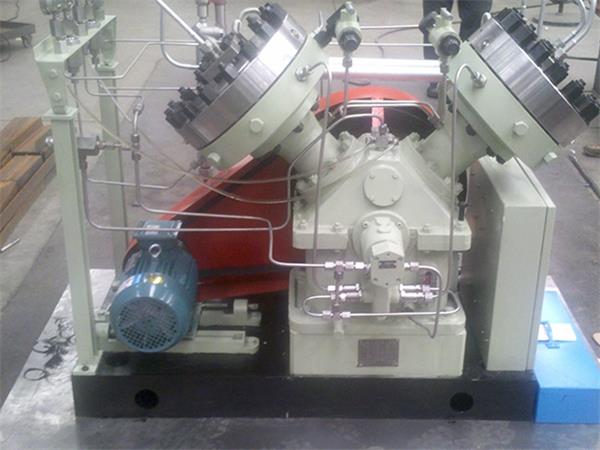Diaphragm compressors play an important role in many industrial fields, but common maintenance issues may arise during their operation. Here are some solutions to address these issues:
Problem 1: Diaphragm rupture
Diaphragm rupture is a common and serious problem in diaphragm compressors. The causes of diaphragm rupture may be material fatigue, excessive pressure, foreign object impact, etc.
Solution: First, shut down and disassemble for inspection. If it is a minor damage, it can be repaired; If the rupture is severe, a new diaphragm needs to be replaced. When replacing the diaphragm, it is important to ensure that a reliable and compliant product is selected. At the same time, check the relevant pressure control system to ensure that the pressure is stable within the normal range and avoid excessive pressure causing diaphragm rupture again.
Problem 2: Valve malfunction
Valve malfunction may manifest as valve leakage, jamming, or damage. This will affect the intake and exhaust efficiency of the compressor.
Solution: Regularly clean the dirt and impurities on the air valve to prevent sticking. For leaking air valves, check the sealing surface and spring. If there is wear or damage, replace the corresponding components in a timely manner. When installing the air valve, ensure the correct installation position and tightening force.
Problem 3: Poor lubrication
Insufficient lubrication or poor quality of lubricating oil may lead to increased wear and even jamming of moving parts.
Solution: Regularly check the oil level and quality of the lubricating oil, and replace the lubricating oil according to the prescribed cycle. At the same time, check the pipelines and oil pumps of the lubrication system to ensure that the lubricating oil can be supplied to each lubrication point normally.
Problem 4: Wear of piston and cylinder liner
After long-term operation, excessive wear may occur between the piston and cylinder liner, affecting the performance and sealing of the compressor.
Solution: Measure the worn parts, and if the wear is within the allowable range, repair can be done through methods such as grinding and honing; If the wear is severe, new pistons and cylinder liners need to be replaced. When installing new components, pay attention to adjusting the clearance between them.
Problem 5: Aging and leakage of seals
Seals will age and harden over time, leading to leakage.
Solution: Regularly check the condition of the seals and replace aging seals in a timely manner. When selecting seals, it is important to choose the appropriate material and model based on the working conditions.
Problem 6: Electrical malfunction
Electrical system failures may include motor failures, controller failures, sensor failures, etc.
Solution: For motor faults, check the windings, bearings, and wiring of the motor, repair or replace damaged components. Conduct corresponding detection and maintenance for controller and sensor faults to ensure the normal operation of the electrical system.
Problem 7: Cooling system issue
Cooling system failure may cause compressor overheating, affecting performance and lifespan.
Solution: Check whether the cooling water pipeline is blocked or leaking, and clean the scale. Check the radiator and fan to ensure they are working properly. For water pump malfunctions, repair or replace them in a timely manner.
For example, there was a problem of diaphragm rupture in a diaphragm compressor at a certain chemical plant. The maintenance personnel first shut down the machine, disassembled the compressor, and checked the degree of damage to the diaphragm. Discovered severe damage to the diaphragm and decided to replace it with a new one. At the same time, they checked the pressure control system and found that the pressure regulating valve had malfunctioned, causing the pressure to be too high. They immediately replaced the regulating valve. After reinstalling the new diaphragm and debugging the pressure system, the compressor resumed normal operation.
In short, for the maintenance of diaphragm compressors, regular maintenance is required to promptly identify problems and adopt correct solutions. At the same time, maintenance personnel should possess professional knowledge and skills, strictly follow the operating procedures for maintenance, to ensure the safe and reliable operation of the compressor.
Post time: Jul-15-2024


